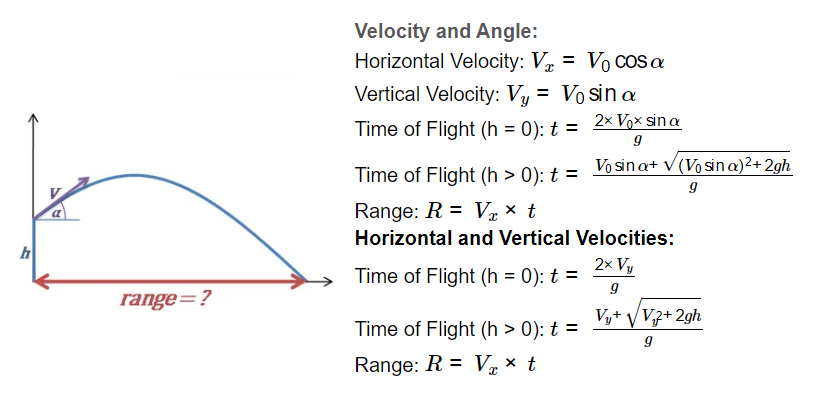1. What is a Projectile Range Calculator?
Definition: This calculator determines the horizontal range of a projectile, along with its horizontal and vertical velocity components, given the initial conditions.
Purpose: It is used in physics to analyze the horizontal distance traveled by a projectile, aiding in understanding projectile motion in ballistics, sports, and engineering.
2. How Does the Calculator Work?
The calculator supports two input methods:
Velocity and Angle:
- Horizontal Velocity: \( V_x = V_0 \cos \alpha \)
- Vertical Velocity: \( V_y = V_0 \sin \alpha \)
- Time of Flight (h = 0): \( t = \frac{2 \times V_0 \times \sin \alpha}{g} \)
- Time of Flight (h > 0): \( t = \frac{V_0 \sin \alpha + \sqrt{(V_0 \sin \alpha)^2 + 2gh}}{g} \)
- Range: \( R = V_x \times t \)
Horizontal and Vertical Velocities:
- Time of Flight (h = 0): \( t = \frac{2 \times V_y}{g} \)
- Time of Flight (h > 0): \( t = \frac{V_y + \sqrt{V_y^2 + 2gh}}{g} \)
- Range: \( R = V_x \times t \)
Where:
- \( R \): Range (cm, m, in, ft, yd, km, mi)
- \( V_x \): Horizontal velocity (m/s, km/h, ft/s, mph, kn, ft/min)
- \( V_y \): Vertical velocity (m/s, km/h, ft/s, mph, kn, ft/min)
- \( V_0 \): Initial velocity (m/s, km/h, ft/s, mph, kn, ft/min)
- \( \alpha \): Launch angle (degrees, radians)
- \( h \): Initial height (cm, m, in, ft, yd, km, mi)
- \( g \): Gravitational acceleration (m/s², ft/s²)
Unit Conversions:
- Velocity Units (V₀, V_x, V_y): m/s, km/h, ft/s, mph, kn, ft/min
- Angle Units (α): degrees, radians
- Height Units (h, R): cm, m, in, ft, yd, km, mi
- Gravity Units (g): m/s², ft/s²
Steps:
- Select the input method (Velocity and Angle or Horizontal and Vertical Velocities)
- Enter the required velocity and angle or velocity components, selecting the units
- Enter the initial height (h), selecting the unit
- Enter the gravitational acceleration (g), selecting the unit (default is 9.81 m/s²)
- Convert all inputs to SI units (m/s, radians, m, m/s²)
- Calculate the horizontal and vertical velocities (if using velocity and angle)
- Calculate the time of flight and range
- Select the desired units for the results and view the values
3. Importance of Projectile Range Calculation
Calculating the projectile range is crucial for:
- Physics Education: Understanding the horizontal component of projectile motion.
- Sports and Ballistics: Predicting the distance a ball or projectile will travel.
- Engineering and Safety: Designing trajectories for safety in scenarios like artillery or sports equipment.
4. Using the Calculator
Examples:
- Example 1 (Velocity and Angle, h = 12 m): Initial velocity \( V_0 = 25 \, \text{m/s} \), angle \( \alpha = 12^\circ \), initial height \( h = 12 \, \text{m} \), gravity \( g = 9.81 \, \text{m/s}^2 \):
- Angle in radians = \( 12 \times \frac{\pi}{180} = 0.2094 \, \text{rad} \)
- Horizontal velocity = \( 25 \cos(0.2094) = 24.451 \, \text{m/s} \)
- Vertical velocity = \( 25 \sin(0.2094) = 5.201 \, \text{m/s} \)
- Time of flight = \( \frac{5.201 + \sqrt{(5.201)^2 + 2 \times 9.81 \times 12}}{9.81} = \frac{5.201 + \sqrt{27.05 + 235.44}}{9.81} = \frac{5.201 + 16.197}{9.81} = 2.181 \, \text{s} \)
- Range = \( 24.451 \times 2.181 = 53.335 \, \text{m} \)
- Example 2 (Horizontal and Vertical Velocities, h = 0): Horizontal velocity \( V_x = 20 \, \text{m/s} \), vertical velocity \( V_y = 10 \, \text{m/s} \), initial height \( h = 0 \, \text{m} \), gravity \( g = 9.81 \, \text{m/s}^2 \):
- Time of flight = \( \frac{2 \times 10}{9.81} = 2.038 \, \text{s} \)
- Range = \( 20 \times 2.038 = 40.760 \, \text{m} \)
5. Frequently Asked Questions (FAQ)
Q: What is the projectile range?
A: The projectile range (\( R \)) is the horizontal distance traveled by a projectile from launch to landing.
Q: Why does initial height affect the range?
A: A non-zero initial height increases the time of flight, allowing the projectile to travel a greater horizontal distance.
Q: What happens if the launch angle is 0°?
A: At 0°, the projectile travels horizontally, and the range depends on the initial height and velocity, but the vertical velocity is 0.
Projectile Range Calculator© - All Rights Reserved 2025
 Home
Home
 Back
Back
